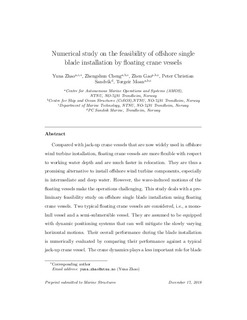| dc.contributor.author | Zhao, Yuna | |
| dc.contributor.author | Cheng, Zhengshun | |
| dc.contributor.author | Gao, Zhen | |
| dc.contributor.author | Sandvik, Peter Christian | |
| dc.contributor.author | Moan, Torgeir | |
| dc.date.accessioned | 2019-11-18T12:26:29Z | |
| dc.date.available | 2019-11-18T12:26:29Z | |
| dc.date.created | 2019-05-30T14:07:41Z | |
| dc.date.issued | 2019 | |
| dc.identifier.citation | Marine Structures. 2019, 64 442-462. | nb_NO |
| dc.identifier.issn | 0951-8339 | |
| dc.identifier.uri | http://hdl.handle.net/11250/2629034 | |
| dc.description.abstract | Compared with jack-up crane vessels that are now widely used in offshore wind turbine installation, floating crane vessels are more flexible with respect to working water depth and are much faster in relocation. They are thus a promising alternative to install offshore wind turbine components, especially in intermediate and deep water. However, the wave-induced motions of the floating vessels make the operations challenging. This study deals with a preliminary feasibility study on offshore single blade installation using floating crane vessels. Two typical floating crane vessels are considered, i.e., a mono-hull vessel and a semi-submersible vessel. They are assumed to be equipped with dynamic positioning systems that can well mitigate the slowly varying horizontal motions. Their overall performance during the blade installation is numerically evaluated by comparing their performance against a typical jack-up crane vessel. The crane dynamics plays a less important role for blade installation by floating vessels, compared to the jack-up crane vessel. The floating vessels’ wave-induced motion greatly affects the blade motion. The semi-submersible vessel causes a much smaller blade motion than the mono-hull vessel. The results indicate that it is feasible to install offshore wind turbine blades by using floating crane vessels provided that the vessel type is properly selected. From the operability point of view, semi-submersible vessels are more feasible than mono-hull vessels for offshore single blade installations. | nb_NO |
| dc.language.iso | eng | nb_NO |
| dc.publisher | Elsevier | nb_NO |
| dc.rights | Attribution-NonCommercial-NoDerivatives 4.0 Internasjonal | * |
| dc.rights.uri | http://creativecommons.org/licenses/by-nc-nd/4.0/deed.no | * |
| dc.title | Numerical study on the feasibility of offshore single blade installation by floating crane vessels | nb_NO |
| dc.type | Journal article | nb_NO |
| dc.type | Peer reviewed | nb_NO |
| dc.description.version | acceptedVersion | nb_NO |
| dc.source.pagenumber | 442-462 | nb_NO |
| dc.source.volume | 64 | nb_NO |
| dc.source.journal | Marine Structures | nb_NO |
| dc.identifier.doi | 10.1016/j.marstruc.2018.12.001 | |
| dc.identifier.cristin | 1701582 | |
| dc.description.localcode | © 2018. This is the authors’ accepted and refereed manuscript to the article. Locked until 29.12.2020 due to copyright restrictions. This manuscript version is made available under the CC-BY-NC-ND 4.0 license http://creativecommons.org/licenses/by-nc-nd/4.0/ | nb_NO |
| cristin.unitcode | 194,64,20,0 | |
| cristin.unitname | Institutt for marin teknikk | |
| cristin.ispublished | true | |
| cristin.fulltext | preprint | |
| cristin.qualitycode | 2 | |

